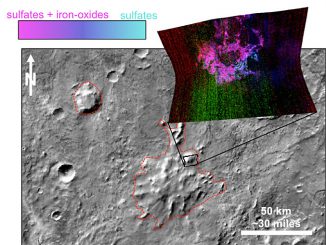
volcanoes



Unusual Martian region leaves clues to planet’s past
Researchers studying the geography and mineralogy of an area on Mars known as Thaumasia Planum, based on Gamma Ray Spectrometer data collected by the Mars Odyssey Orbiter launched in 2001, have found that the mountain ridge outlining Greater Thaumasia was most likely created by a chain of ancient volcanoes.

Freezing effects of Jupiter’s shadow on Io’s volcanic gases revealed
A team of scientists has documented atmospheric changes on Io, Jupiter’s volcanically active satellite, as the giant planet casts its shadow over the moon during daily eclipses. Io’s thin atmosphere collapses as the sulfur dioxide gas emitted from volcanoes freezes when shaded by Jupiter. The atmosphere reforms when Io moves out of eclipse and the ice sublimates.

See Mars before it gets too distant, lost in the dusk twilight
Mars lies highest in the sky to the south soon after sunset at the beginning of July for observers in the UK, so you should not waste any opportunities to view the Red Planet while it is close and still relatively large in size. Tharsis, the great Martian volcanic plateau that is home to the largest volcanoes in the solar system, is turned toward Earth in the first week of the month.

Evidence builds for ancient under-ice volcanoes on Mars
Volcanoes erupted beneath an ice sheet on Mars billions of years ago, far from any ice sheet on the Red Planet today, new evidence from NASA’s Mars Reconnaissance Orbiter suggests. The research about these volcanoes helps show there was extensive ice on ancient Mars. Such an environment combining heat and moisture could have provided favourable conditions for microbial life.

Underground magma ocean could explain Io’s ‘misplaced’ volcanoes
Jupiter’s moon Io is the most volcanically active world in the solar system, with hundreds of volcanoes, some erupting lava fountains up to 250 miles high. New NASA research suggests that tides flowing in a subsurface ocean of molten rock, or magma, could explain why Io’s volcanoes appear in the “wrong” place compared to models that predict how the moon’s interior is heated.

